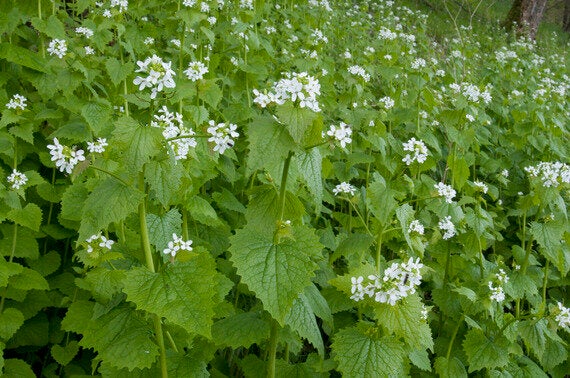Hedge Garlic or Jack by (or in) the Hedge Alliaria petiolata is a wild herb that is as easily accessible to townsfolk as to those living in the country.

Jack by the Hedge ©Pete Moore / CicoBooks
The key to its likely location is in one of its colloquial names - hedge. City foragers may with luck, find poor man's mustard or garlic mustard nestled between tarmac and garden or supermarket fences. It often grows in abundance on waste ground. Avoid picking garlic mustard in areas where pets are walked or near busy roadsides. This fast growing member of the Brassicaceae family dislikes the glare of the sun. Eagle-eyed gardeners may find it banking shady borders as they weed. Bruise a leaf of hedge garlic between your finger and thumb to release a light garlic aroma. Jack by the Hedge may be described as a groupie; find one plant and it is probably the start of a lengthy border.Reference to Jack (Jill gets an occasional look in) in folklore means common, its inclusive, there for everyman (or woman). Jack by the Hedge is well named. Its larger leaves are heart shaped and smaller ones (closer to the tip) are pointed, almost triangular. Left to its own devices, Jack by the Hedge can grow up to 1-2 metres. The white flowers (April-July) are in leafless clusters, each with four petals in the shape of the St George cross. The flowers look pretty in a salad.
Use scissors and cut a few leaves from each plant. Hedge garlic however, is a wild herb that a forager doesn't need to fret over because it is plentiful. Indeed it is considered invasive in some areas of the USA. Some wonder there is a garlic mustard cookery book titled From Pest to Pesto.
Jack by the Hedge is considered a nutritious spring green, and it can be found as early as February, if the weather is kind. A second harvest can be gathered in a mild autumn but it is tricky to identify unless you can see its flowers. After the plants become 'leggy' the leaves toughen. The leaves at the top are the most tender. The taste is a combination of garlic and mustard with a pleasant albeit slightly bitter after taste.
Add finely chopped hedge garlic leaves for bite and a hint of garlic and colour to salads, dips, mayonnaise and sandwiches. Use the leaf in pesto, frittatas and soups or add it at the last minute to sauces - one of its local names is Sauce-Alone. Chop the leaves in place of mint, for an instant sauce to eat with lamb. Pick and cook as fast as you can because the leaves wilt. One final word of advice beware of overcooking Jack, it is best eaten raw.
Hedge Garlic & Tomato Bruschettas
(an adaptation of a recipe from The Forager's Kitchen)
Makes 15-20
4 ripe tomatoes (400g)
Zest ½ small orange, scrubbed
1½ French style batons
1 tbsp Extra Virgin Olive Oil
4tbsps. Hedgerow Garlic, washed and chopped
Freshly ground pepper
15-20 Hedge Garlic flowers (optional)
Use a sharp knife to mark a small cross on each tomato and plunge the tomatoes in a bowl of boiling water for 10-15 seconds. Remove with a slotted spoon and plunge the tomatoes in cold water for 10 seconds. Peel the tomato skins. Quarter the tomatoes and remove the seeds. Chop the flesh into small pieces and put it in a large sieve. Finely grate the zest of half the orange and add this to the tomatoes. Leave to drain for at least 20 minutes.
Lightly toast 1cm slices of the bread. Put the drained tomatoes and orange into a mixing bowl and add the olive oil and chopped hedgerow garlic. Mix briefly, season with black pepper and using a teaspoon pile the mixture high on to the toasted bread. Decorate with the flowers and serve as soon as possible.